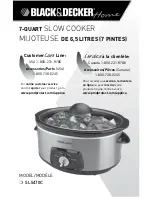
8
9
TIPS when using your slow cooker:
• The stoneware liner should always be filled from ½ to ¾, to avoid over and
under cooking.
o When only half full, check for doneness 1 to 2 hours before recommended
cooking time.
o To avoid spillovers, do not fill slow cooker more than ¾ full.
• Always cook with the lid on.
o do not open lid during first 2 hours of cooking; this allows heat to rise
efficiently.
o open the lid as little as possible, to assure even cooking.
• Most recipes can be cooked on either HIgH or loW. Many recipes will give the
time for both.
• Important: when the appliance is in use, always use pot holders when
handling the lid or the stoneware liner.
Caution: when removing the lid, always lift it away from the body to prevent
getting burnt from the hot steam.
• To save time, fill the stoneware liner the night before and refrigerate. You may
need to add some extra cooking time because the food and stoneware liner are
cold.
• To store the stoneware liner or to place in the refrigerator, invert the lid. It is
easy to use the small lid handle on the bottom of the lid, making it handy to
remove and turn over.
Important: If there is a power outage, the slow cooker will turn off. If this is
discovered quickly, continue cooking when the power is restored. If you are not
sure how long the slow cooker has not been functioning, discard the food.
HINTS ON INGREDIENTS IN THE SLOw COOKER:
DAIRY
• Milk products, especially those low in fat, tend to curdle if cooked too long; add
them toward the end of the cooking time.
• evaporated milk and condensed soups are great substitutes for milk and
cream.
SOUPS AND STEwS
• Because there is little evaporation, soups and stews require less liquid than
usual.
• If too thick, add additional liquid in last ½ hour of cooking or at serving time.
• Condensed soups and dry soup mixes add great flavor and body to sauces.
MEATS
• The higher the fat content, the less liquid needed. Also, place thickly sliced
onions under fattier meat to keep it above the drippings.
• Browning before cooking in the slow cooker is not necessary; however,
browning meats, lightly coated in flour gives more body and flavor to sauces.
This works for ground meat as well.
• Make sure top of meat does not touch the lid.
ENGLISH
• Cooking times are an estimate and will vary depending upon the size of the
meat, the bones and the cut.
Meat with bone in will take longer to cook.
lean meats and poultry will cook faster.
• Meats slow cooked in liquids develop great flavor with a minimum of effort.
• Use HIgH for more tender cuts of meat; use loW for tougher cuts.
VEGETABLES
• Place vegetables below or on the sides; they usually take longer to cook
than the meat.
• Vegetables cook well; they develop better flavor and don’t break down as
they would in your oven.
FISH
• Fish cooks quickly; add it for the last 15 minutes.
BEANS
• do not add dried beans to the slow cooker; cook them first.
• Canned beans are the perfect substitute for dried beans.
SEASONINGS
• Fresh herbs should be added at the end of the cooking cycle. If cooked too
long they lose their color and flavor.
• dried herbs work well in the slow cooker and can be added at the
beginning. They can become stronger on longer cooking; begin with less
and add at end, if needed.
• Some spices and dried herbs, such as cinnamon sticks, bay leaves and
whole peppercorns can become quite intense with long cooking, so use
sparingly.
• If using bay leaves, remember to remove before serving.





































